The first release in the latest generation of Berghaus’s much-loved Remote Hike packs, the compact yet capable Remote Hike 23 is a lightweight and agile hiking daypack that fully embraces the ‘fast and light’ ethos which has swept the outdoor scene in recent years.
It borrows the same innovative suspended Freeflow back system we first saw in last year’s eponymous sister range of Freeflow packs but aims for more flexibility and reduced weight. This makes sense, since this 23-litre volume will only need to handle lighter loads.
Commendably, it’s a fair bit cheaper than the Freeflow 24 too (£110 vs £150 RRP). And unlike that pack, which was a generic unisex fit, this one is available in dedicated men’s and women’s versions, which is great to see. The latter has a female-specific harness design for improved load transfer and carrying comfort.
The trampoline-style nylon mesh back panel delivers first class airflow, yet a nicely sculpted foam lumbar pad and low-profile straps and hip belt make for a snug, stable fit. It strikes a great balance, and the pack never feels like it’s levering away from you, even when fully loaded. It’s easy to load too, since that back system doesn’t intrude on the main compartment.
Access is via an extended clamshell zipper opening, and a white-coloured liner fabric makes it easy to see the contents. The pack has hydration compatibility, two large zippered hipbelt pockets, dual angled side water bottle pockets and two stretch mesh drop pockets on the shoulder straps, similar to those found on running vests.
These features all point to the pack’s emphasis on fast-paced activity, with plenty of easy access storage. There’s also a top zippered pocket with a key clip and a front shove pocket with a top buckle cinch for compression and a lower drain hole, so it won’t fill with water.
Find the women's version here.
Pros
- Lightweight
- Excellent balance between stability and ventilation
- Great features
- Well priced
Cons
- Fixed back length
- No raincover
| RRP: | £110 |
| Weight: | 0.91kg / 2lb 1oz |
| Volume: | 23 litres |
| Sizes: | One size (but men’s and women’s models) |
Back system
Earlier generations of the Remote Hike packs had relatively simple back systems: two long foam panels with a central spine channel for airflow, overlaid with mesh. The new Freeflow system is a lot more sophisticated, aiming to blend elements of both fully suspended mesh and contact-style back systems to create a daypack with the benefits of both.
According to the brand, it has been “engineered to deliver genuine evolution in frame design, suspending the pack away from the back without compromising on stability or packing space”. This is basically the dream for a summer hiking backpack, especially if you’re moving fast over more demanding terrain.
Why? Because, while suspended mesh (trampoline-style) back systems offer amazing breathability, they often compromise on stability (as well as affecting on main compartment storage space and ease of packing).
In contrast, contact back systems – where your back is always in direct contact with a frame sheet or panel – feel very stable with a close-to-the-body fit, but they can be very sweaty. Ideally, you’d want the best of both worlds.
I think Berghaus has absolutely nailed it. The pack is built on a lightweight yet rigid plastic (polypropylene) frame with a contoured shape that tapers at the base. It provides structure and solidity with just a touch of flex.
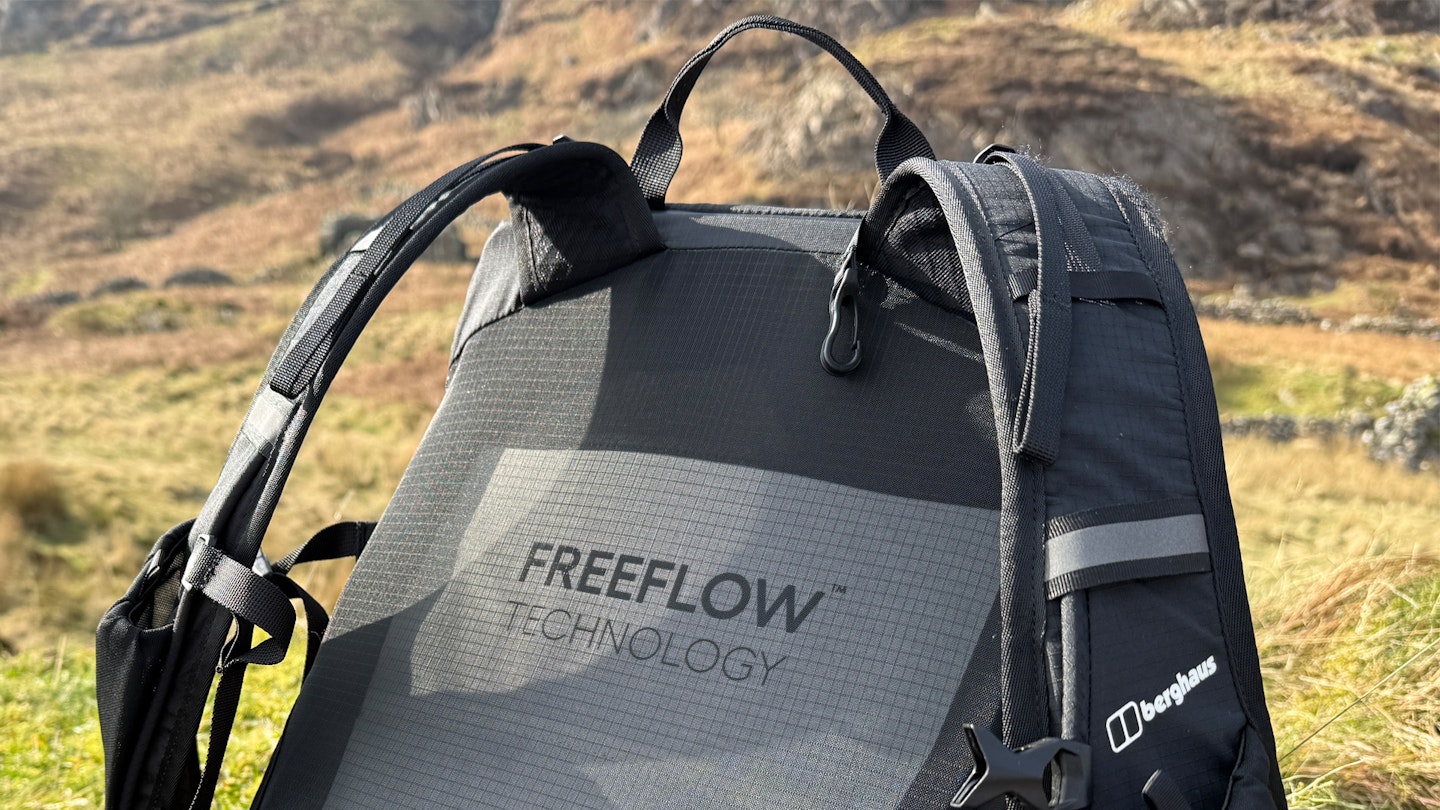
Inside the pack, there’s a partial framesheet positioned across the shoulders, with a horizontal stay to prevent barrelling. Tensioned webbing straps attached to this stay effectively pull the nylon back panel taut, creating that trampoline effect against your back, whilst holding the rest of the pack body away for maximum airflow.
You get a consistent air gap of between 2cm and 4cm, providing excellent ventilation to minimise sweating. However, it's possible to adjust the internal webbing straps if you want the nylon mono mesh material to offer a bit more ‘give’.
This would help offset the overall carrying experience, which is quite firm, straight and structured – though for many this will work well.
Weight distribution is top-notch, as is load transfer to the hips, thanks in part to a well sculpted perforated foam lumbar pad at the base, which nestles snugly into the lower back and works well with the integrated hip fins.
Are there any drawbacks? The only element that might cause concern is the polypropylene plastic frame. Though it feels strong and sturdy, many plastics tend to become brittle over time. And if the pack got dropped or thrown around too often, it seems more likely to crack or snap than a perimeter wire frame, which – at worst – you can normally just bend back into shape.
One other drawback of the Freeflow back system is that it isn’t adjustable. This means that if you’re at either end of the bell curve when it comes to height (i.e. unusually tall or short), you might be better served with a pack that either comes in multiple sizes and/or has an adjustable torso length, such as those from Deuter or Osprey.
Harness and hip belt
The harness clearly draws inspiration from a running vest, with the focus on providing a low-profile, close-to-the-body fit. It’s nicely contoured, giving great arm mobility, which is perfect for faster paced hiking. The hip fins also hug the body snugly and feel very stable.
The waist belt fastens with a standard side release plastic buckle, which is nice and chunky. Unusually though, it’s positioned at the left side. Once we got used to this arrangement we grew to really like it, since it means there’s no bulky plastic buckle digging into your belly.
Neither the straps nor the hip belt is particularly well padded. They’re made from sculpted foam, overlaid with fast-wicking mesh with a diamond-grid ripstop yarn running through it. The emphasis is definitely on breathability rather than cushioning but given that you’re unlikely to be hauling mega loads in a 23-litre daypack, this approach is logical.
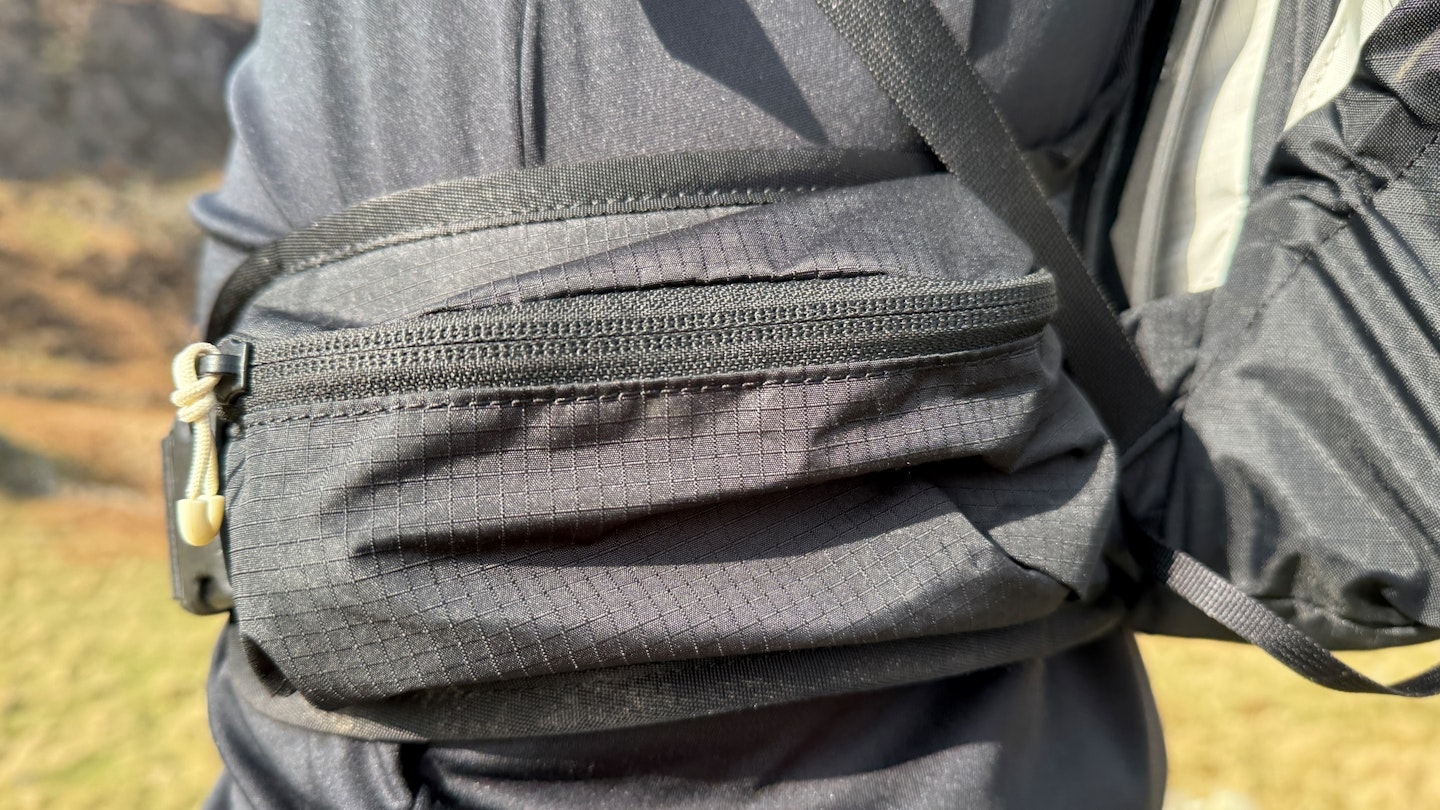
Since there are gender-specific versions of the Remote Hike 23, the harness is designed differently for men and women, with male and female contouring to further improve carrying comfort.
The shoulder straps are fitted with load lifters and a sliding sternum strap. You also get a bungee cord for quickly stashing trekking poles, which works with a lower webbing loop on the base of the pack, just like other brands’ ‘stow on the go’ systems.
The harness has four useful pockets – two stretch mesh pockets on the shoulder straps, plus two roomy zippered pockets on the hip fins. Any of these will fit even the chunkiest smartphone, which is a rare virtue on a mid-sized daypack.
Design and features

Our test sample of the Remote Hike 23 tipped the scales at 910g, which is commendably light for a pack of this size. In contrast, the Berghaus Freeflow 24 weighs 1,280g, while the Osprey Talon 22 weighs 1,030g. In terms of overall shape, the pack has a neat, broadly rectangular profile, with a tapered base.
It has official dimensions of 54cm (height) x 22cm (width) x 31cm (depth). Unlike a lot of rivals, it doesn’t flare at the hips, but this doesn’t noticeably affect load transfer while keeping the silhouette nice and slim.
As noted, up top, the pack is a zippered panel-loader with a wraparound, two-way clamshell zipper. This provides easy and simple access to the main compartment. The only drawback is that the top of the pack is more exposed to the elements and lacks the extra layer of rain protection you get with a traditional lid.
The main zipper is also partly obstructed by the side compression straps. You’ll need to unbuckle them first if you want to fully unzip it.
The main compartment is lined in white fabric to make things easy to find, which is a nice touch. Inside there's a hanging loop and sleeve for a hydration bladder, with an exit port for a drinking tube at the right shoulder.
Another noticeable feature of the main compartment is a floating pocket, which is accessed via an external, zippered pocket on the top of the bag. It’s fitted with a plastic clip to keep car keys safe.
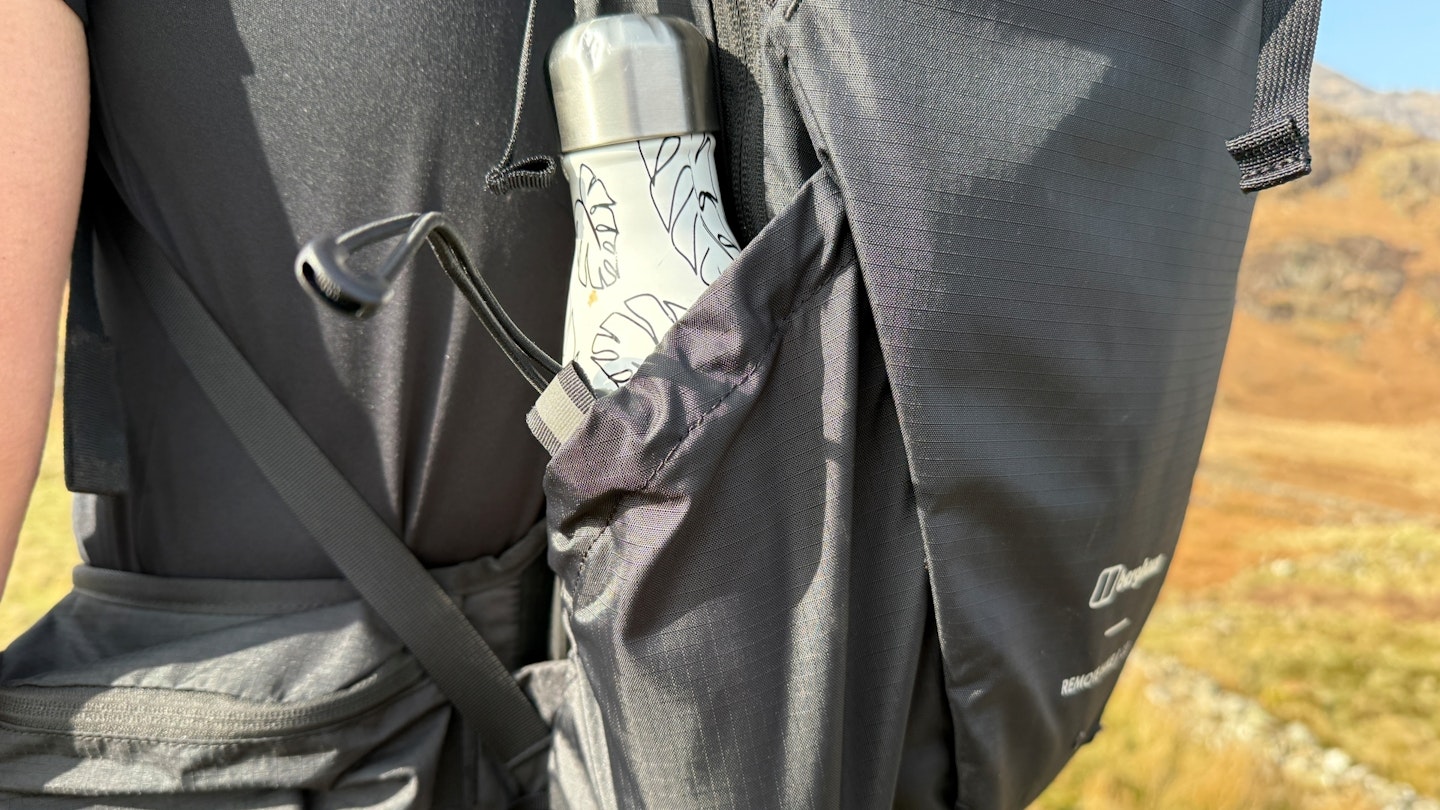
Externally you get twin side bottle pockets, which are angled to enable you to get to them without taking the pack off. They’re not the deepest and they’re made from fabric rather than mesh.
This means they’re not as stretchy or flexible as some – but on the other hand, they’re less likely to snag. They’re also fitted with elastic drawcords to hold bottles in tightly, which can be clipped to cord loops on the pack frame for added security.
The front of the pack has small trekking pole loops and daisy chain webbing so you can attach bungee cords for extra kit if desired. However, most of the front panel consists of a practical shove pocket, which is made from double-layer fabric for durability.
It’s partly gusseted to provide expanding storage and secures with a central buckle for compression. It’s a good space to stash extra layers on the move and has a bottom drain hole so rain won’t just collect in the bottom of the pocket.
We’d say this is still a pack better suited to mainly dry, warm weather adventures rather than anything too soggy – not least because the pack lacks a raincover. The main zip also looks a bit susceptible to water ingress. It’s a reverse coil design but isn’t protected by a storm flap.
Sustainability
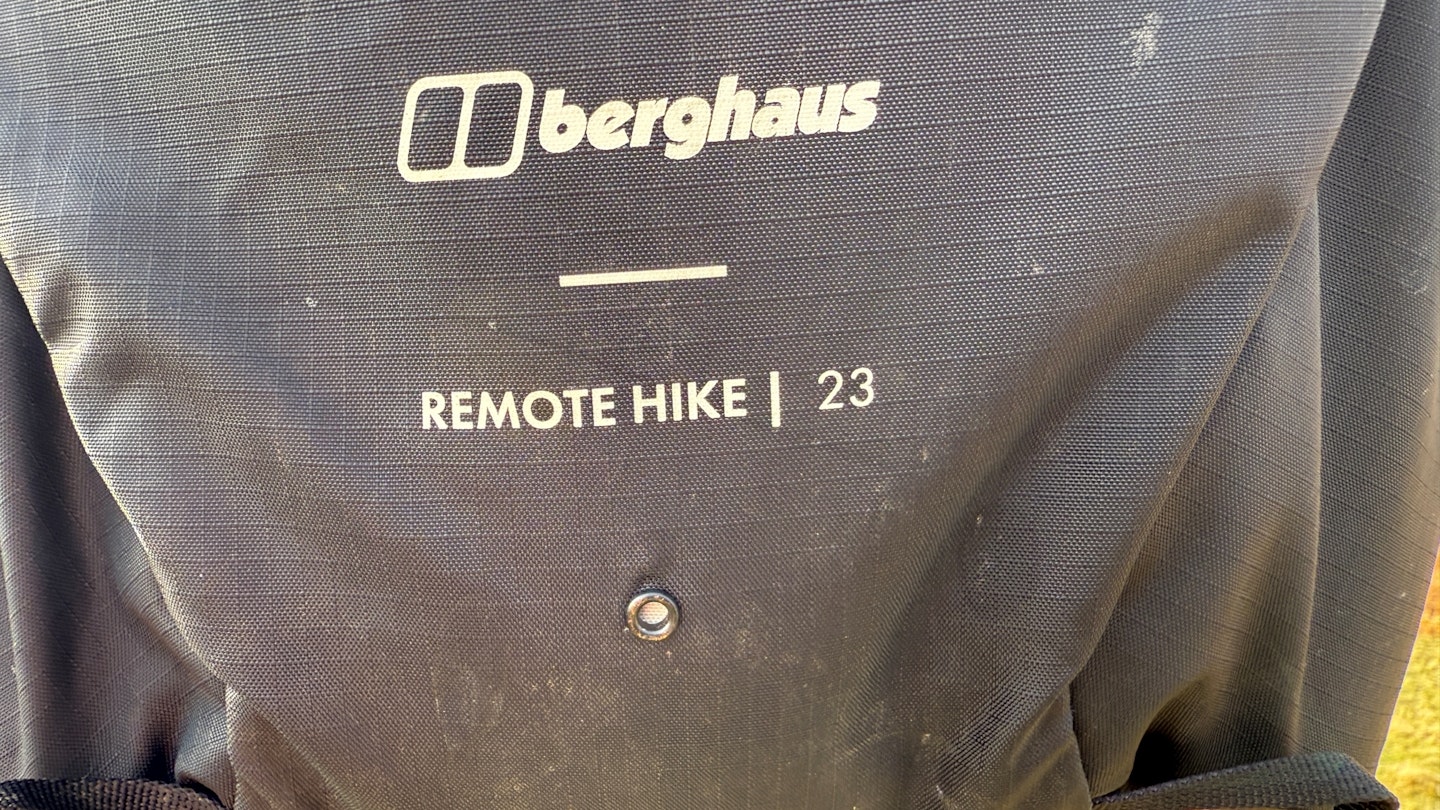
The Remote Hike 23 makes use of recycled materials. The main fabric of the pack is 100% recycled Seawastex, a nylon fabric made entirely of recycled ocean waste, from clutch strings to other used oyster farm materials.
Berghaus is also keen to highlight sustainability through longevity, via its ‘Fixed for Life’ promise. Its in-house Repairhaus team can “stitch any rip or replace any zip, if they possibly can, as many times as you need them to”. Repairs are free – you’ll have to pick up the cost of sending your gear into them, but the fix-up is on the house.
Price and competition
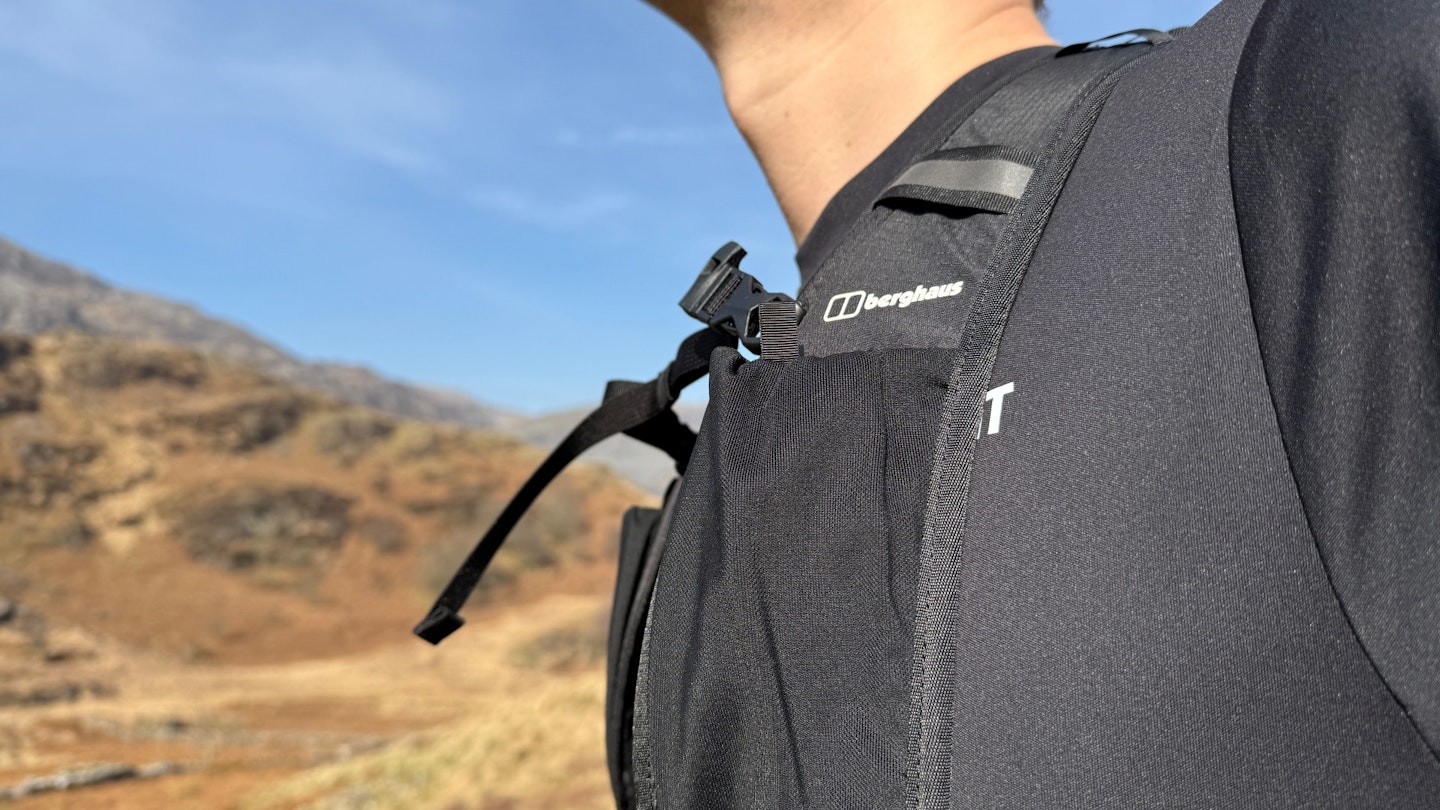
Whereas 2024’s Berghaus Freeflow 24 pack was priced at £150, the new Remote Hike 23 – which is pretty much the same volume when it comes to real world carrying capacity – has a UK RRP of £110. It’s also cheaper than established market leaders in this class, like the Osprey Talon/Tempest 22 (£125).
In that sense, we think it’s pretty good value, not least when you also consider that it shares the same innovative frame/back system and has many of the same features as the Freeflow 24, whilst being lighter overall. And unlike the unisex Freeflow 24, it’s available in gender-specific variants to ensure a superior fit for men and women (or taller/broader and shorter/narrower builds).
Of course, you can get good daypacks of a similar size for slightly less. Good examples are the Mammut Lithium 25 (£95) and the Deuter AC Lite 23/21 SL (also £95), both of which come in women’s-specific fits. For taller hikers there’s also the Deuter AC Lite 25 EL (£100).
Alternatively, if you’re not bothered about the extra comfort that usually comes with a dedicated gender-specific fit and/or are on a tight budget, you could also look at bona fide bargains like the unisex Highlander Venture 20 (£30), the new Vango Mitra Air 20 (£62.50), the Alpkit Presta 25 (£70) or the Sprayway Akka 30 (£75). These are all much simpler packs that lack the great back ventilation of the Remote Hike 23 though.
Verdict
There’s lots to like about the Remote Hike 23, particularly the Freeflow back system, which is a triumph. It delivers more structure and firmness than other suspension systems we’ve tested without losing that stable feel, yet breathability and ventilation are still excellent.
Its practical pockets are ideal for on-the-go access, too. The result is a light and compact daypack that works really well for fast, agile hill days. Best of all, the price is a little lower than many comparable rivals.
If you like the look of this pack but want to do more comparisons, check out our Exped Skyline 30 review and see which pack is best for you.
Shop this product
About the author

Matt Jones is a freelance journalist based in the heart of Snowdonia National Park, he’s a vastly experienced gear tester and self-confessed outdoor kit geek. Matt’s been one of our main gear testers for the last couple of years and is the first person we call with any complicated kit queries that need in-depth and forensic analysis.



